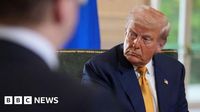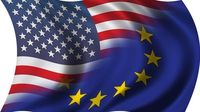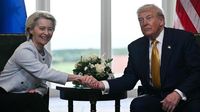In a move set to reshape the transatlantic economic landscape, the United States and the European Union have unveiled a sweeping trade framework that slashes tariffs, opens markets, and lays the groundwork for unprecedented investment and industrial cooperation. Announced in a joint statement on August 21, 2025, the agreement follows weeks of high-stakes negotiations and a pivotal July meeting between President Donald Trump and European Commission President Ursula von der Leyen at Trump’s Turnberry golf course in Scotland.
The heart of the deal is a blanket 15% tariff imposed by the U.S. on imports of European cars, pharmaceuticals, and a range of other products—a significant reduction from the previously threatened 30% rate. In return, the EU has pledged to eliminate tariffs on all American industrial exports and to grant preferential market access for U.S. seafood and farm products, including dairy, fruits, vegetables, soybean oil, pork, and bison meat. According to the joint statement, this framework is “a concrete demonstration of our commitment to fair, balanced, and mutually beneficial trade and investment.”
Both sides emphasized the historic scale of the agreement. The U.S. and EU together account for 44% of the global economy, making this partnership one of the most consequential in the world. The pact is designed not merely as a truce in ongoing trade tensions but as a catalyst for what the White House and EU called a reinvigoration of “our economies’ reindustrialization.”
Among the most notable provisions, the EU committed to purchasing $750 billion worth of American energy and to investing an additional $600 billion in the U.S. by 2028. The EU also agreed to substantially increase its procurement of U.S. military and defense equipment—a move that has sparked debate among European officials, but which the U.S. views as a strategic win.
On the technology front, the EU pledged to buy at least $40 billion in U.S. artificial intelligence chips for its computing centers, signaling a deepening of technological collaboration at a time when global competition in AI is fierce. Furthermore, both parties agreed to streamline requirements for sanitary certificates on pork and dairy products, aiming to reduce non-tariff barriers that have long frustrated exporters on both sides.
The framework also addresses regulatory hurdles, with the EU promising to “address the concerns of U.S. producers and exporters regarding the EU Deforestation Regulation, with a view to avoiding undue impact on U.S.-EU trade.” This nod to environmental and trade policy alignment reflects the growing complexity of global commerce, where regulations can be as significant as tariffs in shaping market access.
For the automotive sector, the U.S. will lower its tariffs on European auto imports from 27.5% to 15% once the EU enacts its own legislation to cut tariffs on U.S. industrial goods. A senior Trump administration official told reporters that this legislative step could be completed within weeks, paving the way for immediate relief to automakers and suppliers on both sides of the Atlantic.
Other sectors are also in the spotlight. While the 15% tariff applies broadly, the agreement specifies that “Most Favored Nation” rates below 15% will be imposed on aircraft and aircraft parts, generic pharmaceuticals (including their ingredients and chemical precursors), and certain natural resources such as cork. The U.S. has also capped tariffs on semiconductors and lumber at 15%, a notable shift after President Trump’s earlier announcement of a 100% tariff on all semiconductor imports.
Looking ahead, the U.S. and EU have agreed to consider discounted rates on steel, aluminum, and derivative products under a quota system, though details remain to be hammered out. The joint statement hints at future negotiations that could extend to wine, spirits, and medical devices—sectors with significant transatlantic trade flows and, at times, contentious regulatory differences.
Reactions to the agreement have been mixed, reflecting the complexity of balancing national interests with the broader goal of economic integration. Maros Sefcovic, the EU’s trade commissioner, described the deal as “the most favorable” ever reached between the U.S. and any of its trade partners. “But this is not the end,” Sefcovic added. “This is the beginning. This framework is the first step, one that can grow over time to cover more sectors, improve market access and strengthen our economic ties further.”
However, not all voices in Europe are celebrating. French Prime Minister Francois Bayrou was sharply critical, declaring, “It was a dark day when an alliance of free peoples, united to assert their values and defend their interests, resolves to submissions.” Alice Weidel, head of Germany’s far-right AfD Party, echoed this sentiment, writing, “The EU has been brutally taken advantage of!” She went further, claiming that the agreement for the EU to acquire U.S. military gear and energy “is not an agreement, but a slap in the face for European consumers and producers!”
Despite such criticisms, most EU governments are expected to support the arrangement, given the benefits to key industries like cars and pharmaceuticals. Eurasia Group, a political risk consulting firm, predicted that after full implementation, the average effective U.S. tariff on EU imports would range from 10% to 14%, a level seen as manageable by most stakeholders. The deal also includes provisions to extend a 2020 agreement for lobster imports—previously expired in July—to processed lobster, reflecting the kind of detailed sectoral negotiations that underpin the broader framework.
While the agreement is not yet a finalized trade deal, but rather a framework to facilitate ongoing negotiations, it represents a significant shift from the trade tensions that have marked recent years. The pact was reached just days before a self-imposed U.S. deadline of August 1, 2025, averting the threat of much higher tariffs and signaling a willingness on both sides to compromise.
As the dust settles, both Washington and Brussels appear eager to build on this momentum. The framework sets the stage for further talks, with the potential to expand into new sectors and deepen the U.S.-EU economic partnership. Whether this spirit of cooperation will endure in the face of domestic political pressures and global competition remains to be seen, but for now, the world’s two largest economies have charted a new course—one that could prove transformative for industries and consumers on both sides of the Atlantic.


